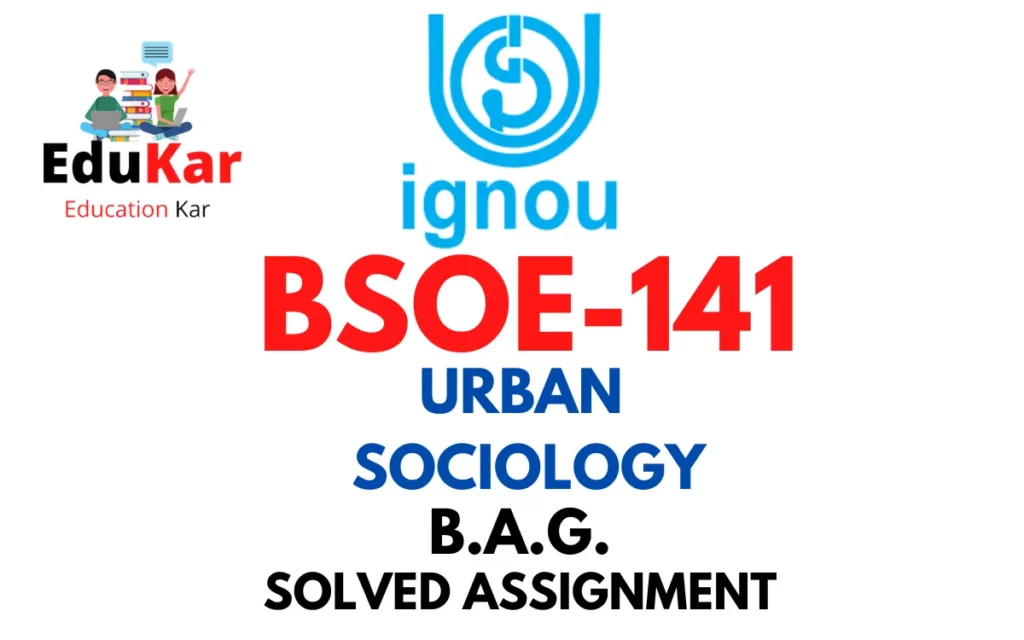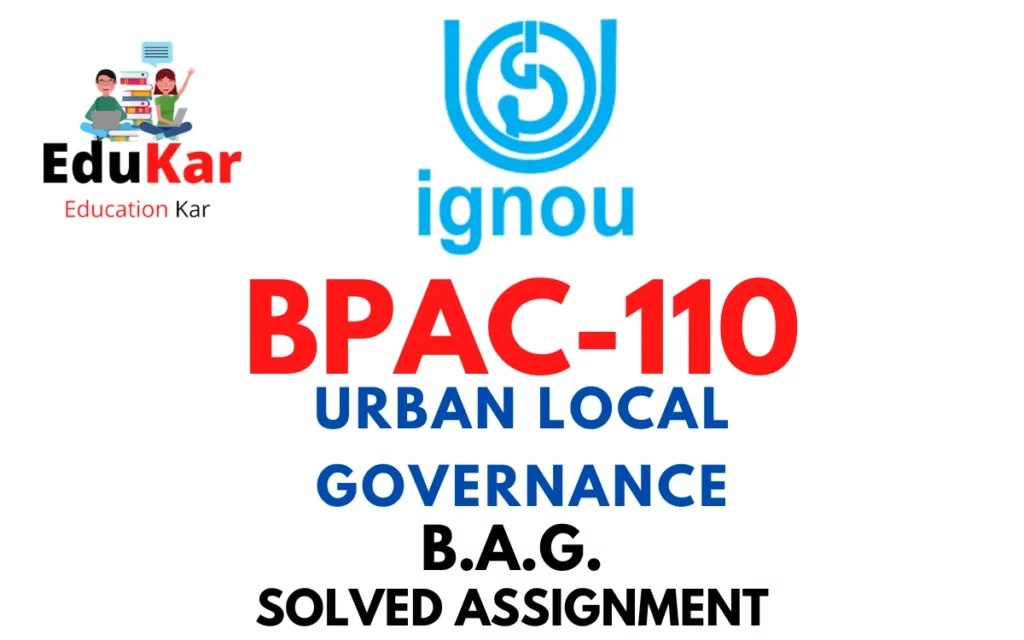Contents
- 1 Assignment – I
- 2 Answer the following in about 500 words each.
- 3 1. How did urban sociology emerge? Discuss the role of the Chicago school of thought with examples.
- 4 2. What do you understand by “New” urban sociology? Explain.
- 5 Assignment – II
- 6 Answer the following questions in about 250 words each.
- 7 3. Discuss the role of “network” in urban society with examples.
- 8 4. How is globalization and network significant in urban sociology? Discuss.
- 9 5. What are slums? Discuss its main features.
- 10 Assignment – III
- 11 Answer the following questions in about 100 words each.
- 12 6. Describe the process of urbanization and the concept of urban.
- 13 7. Describe the concept of urbanism as given by Louis Wirth.
- 14 8. How many types of occupation are found in urban areas? Discuss
- 15 9. Outline the features of a “Gated Community” in big cities.
- 16 10. Discuss the meaning of consumer culture and concept of leisure.

| Title | BSOE-141: IGNOU BAG Solved Assignment 2022-2023 |
| University | IGNOU |
| Degree | Bachelor Degree Programme |
| Course Code | BSOE- 141 |
| Course Name | URBAN SOCIOLOGY |
| Programme Name | Bachelor of Arts (General) |
| Programme Code | BAG |
| Total Marks | 100 |
| Year | 2022-2023 |
| Language | English |
| Assignment Code | ASST /TMA /2022-23 |
| Assignment PDF | Click Here |
| Last Date for Submission of Assignment: | For June Examination: 31st April For December Examination: 30th September |

Assignment – I
Answer the following in about 500 words each.
1. How did urban sociology emerge? Discuss the role of the Chicago school of thought with examples.
Ans: Urban sociology emerged as a subfield of sociology in the late 19th and early 20th centuries as a response to the increasing urbanization of society. The growth of cities during the industrial revolution led to a significant shift in the way people lived and worked, and sociologists began to study these changes in order to better understand the social dynamics of urban life.
One of the most important schools of thought in the early development of urban sociology was the Chicago school. This group of sociologists, who were based at the University of Chicago, played a significant role in shaping the discipline of urban sociology and developing many of the key concepts and methods that are still used today.
The Chicago school was founded in the early 20th century by sociologist Albion W. Small, who was interested in studying the social problems that were emerging in the rapidly growing city of Chicago. One of the key figures in the Chicago school was Robert E. Park, who emphasized the importance of studying the social organization of cities and the interactions between different social groups.
Park and his colleagues conducted a number of influential studies in the city of Chicago, including the famous “Ecology of the City” study, which analyzed the spatial distribution of social groups and the ways in which they interacted with one another. They also conducted a number of other studies on topics such as crime, delinquency, and social disorganization.
One of the most important concepts developed by the Chicago school was that of the “urban ghetto.” This term referred to the neighborhoods in the city where African Americans and other minorities were concentrated, and which were often characterized by poverty, crime, and social disorganization. The Chicago school helped to popularize the term and to draw attention to the social problems that were associated with these neighborhoods.
Another important concept developed by the Chicago school was that of “social capital.” This term referred to the social networks and relationships that people had with one another, and which were seen as critical to their ability to succeed in the city. The Chicago school emphasized the importance of studying these networks and relationships in order to better understand the social dynamics of urban life.
2. What do you understand by “New” urban sociology? Explain.
Ans: The “New” urban sociology is a subfield of sociology that emerged in the 1980s and 1990s as a response to changes in the social and economic structure of cities. It represents a departure from the earlier tradition of urban sociology, which was dominated by the Chicago School and focused primarily on the study of the social organization of cities and the interactions between different social groups.
The New urban sociology places greater emphasis on issues such as globalization, urbanization, and the restructuring of the economy, and seeks to understand the ways in which these factors are shaping the development of cities and the lives of the people who live in them.
One of the key features of the New urban sociology is its focus on the global economy and the ways in which economic restructuring is affecting urban areas. This includes the increasing importance of the service sector, the growth of new industries such as technology and biotech, and the globalization of trade and finance.
Another important aspect of the New urban sociology is its focus on the relationship between urban areas and the broader society. This includes issues such as urban sprawl, gentrification, and the role of cities in promoting social and economic inequality. The New urban sociology also pays close attention to the ways in which social and cultural factors are shaping the development of urban areas, including issues such as race, gender, and sexuality.
The New urban sociology also places a greater emphasis on interdisciplinary research, drawing on insights and methods from a range of different disciplines including geography, anthropology, and political science. This interdisciplinary approach allows for a more nuanced and complex understanding of the social and economic dynamics of cities.
One of the key figures in the development of the New urban sociology was Manuel Castells, who emphasized the importance of studying the relationship between cities and the broader social and economic system. Castells argued that the globalization of the economy was transforming the role of cities, and that it was necessary to study the ways in which this transformation was affecting the lives of urban residents.
Assignment – II
Answer the following questions in about 250 words each.
3. Discuss the role of “network” in urban society with examples.
Ans: In urban society, networks play a crucial role in shaping social and economic interactions. A network can be defined as a group of individuals or organizations that are interconnected and interact with each other for a specific purpose. These networks can be formal or informal and can span a wide range of activities, including economic, social, and political.
One example of the role of networks in urban society is the formation of business networks. In cities, businesses often form networks with each other to gain access to resources, share knowledge and expertise, and collaborate on projects. For instance, in Silicon Valley, startups form networks with venture capitalists and other businesses to secure funding and access to resources. Similarly, in the fashion industry, designers and manufacturers form networks to create and distribute products.
Another example of the role of networks in urban society is the formation of social networks. Social networks can form around shared interests or activities, such as sports, music, or cultural events. These networks can play an essential role in fostering social cohesion and helping people feel connected to their communities. For instance, in New York City, the Gay Men’s Chorus is a social network that brings together LGBTQ+ individuals from all walks of life to sing and perform.
Political networks are also an essential aspect of urban society. These networks are often formed to influence public policy or advocate for specific issues. Political networks can include interest groups, advocacy organizations, and grassroots movements. For example, in London, the London Cycling Campaign is a political network that advocates for better cycling infrastructure and policies in the city.
4. How is globalization and network significant in urban sociology? Discuss.
Ans: Globalization and networks are significant concepts in urban sociology. Globalization refers to the increasing interconnectedness and interdependence of societies and economies across the world. Network, on the other hand, refers to the social and economic relationships that individuals and organizations form to accomplish specific goals.
In urban sociology, the concept of globalization is used to describe how cities are increasingly integrated into global economic and cultural systems. This integration is facilitated by networks of people, information, and goods that flow across borders. Globalization has led to the growth of global cities, which are characterized by their role as centers of economic activity, cultural exchange, and innovation.
One significant effect of globalization on urban sociology is the increased importance of network relationships. Networks of people and organizations are critical for cities to compete in the global economy. In a globalized world, cities need to have strong connections with other cities, businesses, and institutions around the world to attract investment, talent, and innovation. As a result, networks have become essential to the functioning of the global city.
Another effect of globalization on urban sociology is the emergence of new forms of urban inequality. Globalization has created winners and losers in the global economy, and cities have become key sites of both wealth and poverty. Some neighborhoods in global cities have become centers of affluence, while others have been left behind. This creates new challenges for urban sociology, as researchers try to understand the dynamics of urban inequality in a globalized world.
5. What are slums? Discuss its main features.
Ans: Slums are typically defined as densely populated areas of a city with inadequate housing and living conditions. Slums are often characterized by poverty, lack of access to basic services such as water and sanitation, overcrowding, and high levels of informal and precarious employment. Slums are also often associated with crime, social exclusion, and marginalization from the wider society.
The main features of slums include:
- Inadequate Housing: Slums are typically characterized by substandard housing conditions. Housing in slums is often makeshift, lacking basic amenities such as running water, electricity, and proper sanitation. Many slum dwellings are constructed from scrap materials and lack basic safety measures, such as fire exits.
- Overcrowding: Slums are characterized by high population density, with many families living in small and cramped spaces. This leads to a lack of privacy and increased risk of disease transmission.
- Lack of Basic Services: Slums are often located in areas of the city that lack basic services, such as clean drinking water, sanitation, healthcare, and education. This creates significant health and social problems for slum residents, including higher rates of illness and death.
- Informal and Precarious Employment: Slum residents often work in informal and precarious jobs, such as street vending or waste picking, with little job security or protection. Many slum residents are unable to earn a living wage, which further exacerbates poverty and marginalization.
- Social Exclusion: Slum residents often experience social exclusion and marginalization from the wider society. This can lead to a lack of political representation, limited access to resources, and increased vulnerability to violence and crime.
Assignment – III
Answer the following questions in about 100 words each.
6. Describe the process of urbanization and the concept of urban.
Ans: Urbanization is the process by which people migrate from rural areas to urban areas, resulting in the growth of cities and towns. This process is driven by a variety of factors, including economic opportunities, social and cultural factors, and political forces. Urbanization is often associated with the growth of industry and the increasing importance of the service sector, as well as changes in social and cultural norms.
The concept of urban is often used to refer to areas with high population densities and a concentration of buildings and infrastructure. However, the definition of urban can vary depending on the context, and different countries and organizations may use different criteria to define urban areas. Generally, urban areas are characterized by a high level of social and economic complexity, as well as a diverse population and a range of cultural and recreational activities.
7. Describe the concept of urbanism as given by Louis Wirth.
Ans: Louis Wirth was an American sociologist who is well-known for his contributions to the field of urban sociology. One of his most important concepts is that of urbanism, which he defined as a way of life that is characterized by a high level of social and cultural diversity, a complex division of labor, and a focus on individualism and anonymity.
According to Wirth, urbanism is a distinctive way of life that is shaped by the social and economic conditions of cities. In urban areas, people are more likely to encounter strangers and interact with a diverse range of people from different social and cultural backgrounds. This results in a greater degree of individualism and anonymity, as people are less likely to have close personal relationships with the people around them.
In addition, Wirth argued that urbanism is characterized by a complex division of labor, in which people perform specialized tasks and rely on others to provide goods and services that they cannot produce themselves. This results in a higher level of economic interdependence and a greater degree of social and economic complexity.
8. How many types of occupation are found in urban areas? Discuss
Ans: Urban areas are characterized by a diverse range of economic activities and occupations. In general, there are four main types of occupation that are found in urban areas: primary, secondary, tertiary, and quaternary.
- Primary occupations: Primary occupations are those that involve the extraction and production of raw materials. These include activities such as farming, mining, and fishing. While these activities are less common in urban areas than in rural areas, they are still an important part of the economy in many cities.
- Secondary occupations: Secondary occupations involve the processing and manufacturing of goods. These include activities such as construction, manufacturing, and transportation. In urban areas, these occupations are often located in industrial zones or other areas that are designated for heavy industry.
- Tertiary occupations: Tertiary occupations involve the provision of services. These include activities such as healthcare, education, retail, and hospitality. In urban areas, these occupations are often located in commercial areas such as downtown or other shopping districts.
- Quaternary occupations: Quaternary occupations involve the production and dissemination of knowledge and information. These include activities such as research, technology, and professional services such as law, accounting, and consulting. In urban areas, these occupations are often concentrated in areas with high levels of educational attainment and research and development activity.
It is important to note that these categories are not always mutually exclusive, and many occupations may involve elements of more than one category. For example, a software developer might be considered a quaternary occupation, but they may also be involved in the manufacturing of computer hardware (a secondary occupation) or provide consulting services (a tertiary occupation). In addition, the specific mix of occupations found in urban areas can vary widely depending on a range of factors such as the city’s history, geography, and economic structure.
9. Outline the features of a “Gated Community” in big cities.
Ans: Gated communities are residential areas that are enclosed by a physical barrier, such as a wall or fence, and typically have controlled access points. They are designed to provide a sense of exclusivity, security, and privacy to their residents. The features of a gated community in a big city may include:
- Physical barrier: A gated community is typically surrounded by a physical barrier, such as a wall, fence, or gate. The barrier serves as a way to keep non-residents out of the community and create a sense of exclusivity.
- Controlled access points: Gated communities typically have controlled access points, such as a gatehouse, security guards, or electronic access control systems. These access points ensure that only authorized persons are able to enter the community.
- Amenities: Gated communities often have a variety of amenities that are exclusive to their residents, such as a swimming pool, gym, tennis court, or clubhouse. These amenities are designed to provide a high quality of life for the community’s residents.
- Maintenance: Gated communities typically have a maintenance staff that is responsible for the upkeep of common areas, such as landscaping, sidewalks, and roads. This ensures that the community is well-maintained and attractive.
- Sense of community: Gated communities often have a strong sense of community, with neighbors interacting with one another in shared spaces such as the clubhouse or pool. This sense of community can create a feeling of belonging and social support among residents.
- Security: One of the primary reasons people choose to live in gated communities is for the increased security they provide. Gated communities often have security measures such as CCTV cameras, security guards, and other measures in place to deter crime and increase safety for residents.
10. Discuss the meaning of consumer culture and concept of leisure.
Ans: Consumer culture refers to a society in which the consumption of goods and services is a key aspect of social and economic life. In consumer culture, people’s identities, status, and social relationships are often shaped by their consumption choices. Consumer culture has been driven by the growth of mass production and mass marketing, which have made goods and services more widely available to larger numbers of people.
The concept of leisure refers to free time that is available for individuals to pursue activities that are not directly related to work or other obligations. Leisure activities can include hobbies, sports, travel, entertainment, and socializing with friends and family. The concept of leisure has become increasingly important in consumer culture, as people have more disposable income and free time to pursue leisure activities. In some cases, leisure activities have become a form of consumption themselves, with people spending money on experiences, such as travel or entertainment, as a way to express their identity or social status.
How to Download BSOE- 141 Solved Assignment?
You can download it from the www.edukar.in, they have a big database for all the IGNOU solved assignments.
Is the BSOE- 141 Solved Assignment Free?
Yes this is absolutely free to download the solved assignment from www.edukar.in
What is the last submission date for BSOE- 141 Solved Assignment?
For June Examination: 31st April, For December Examination: 30th October
















